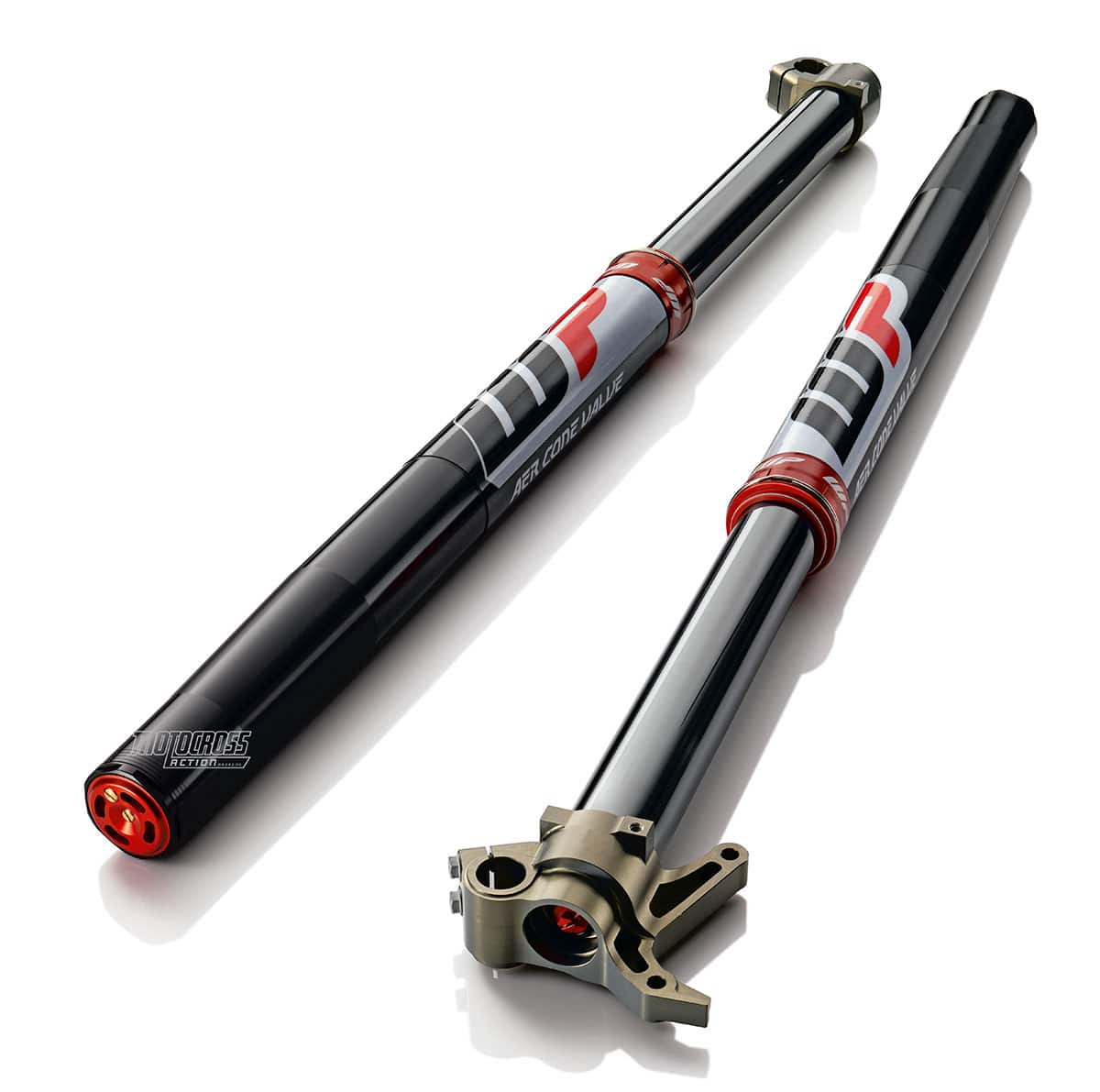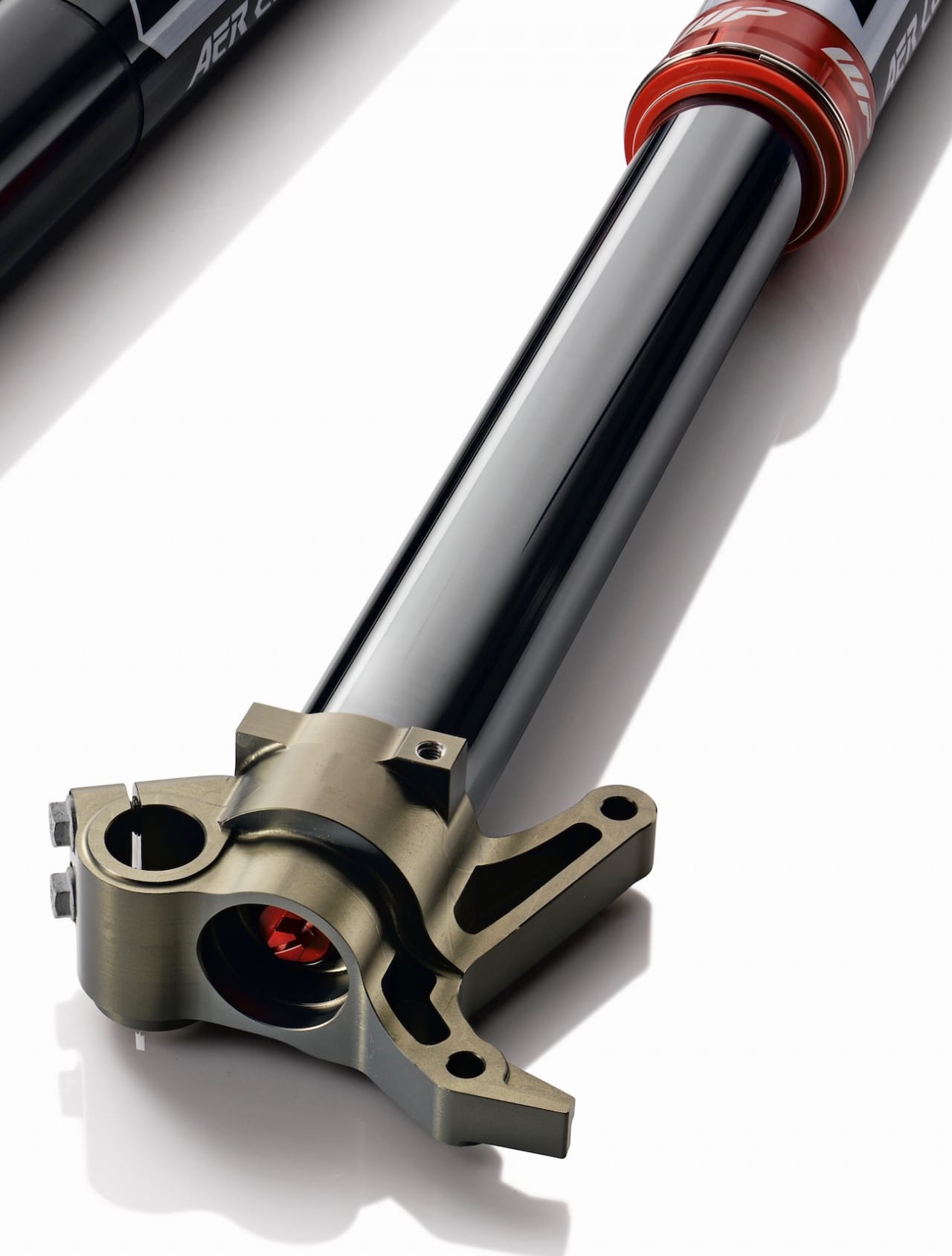TEN THINGS ABOUT THE NEW GENERATION OF WP XACT FORKS
 (1) A rose by any other name. What does XACT mean? It means exactly what it sounds like—exact. In case you didn’t know, WP’s previous AER acronym was not an acronym but the Greek word for “air.” There are three new XACT models—XACT Air, XACT Pro Air and XACT Pro Spring.
(1) A rose by any other name. What does XACT mean? It means exactly what it sounds like—exact. In case you didn’t know, WP’s previous AER acronym was not an acronym but the Greek word for “air.” There are three new XACT models—XACT Air, XACT Pro Air and XACT Pro Spring.
(2) XACT Air. The XACT Air fork is the genetic brother of the previous production-based WP AER Air fork. It has air pressure in the left fork leg and the valve stack and fork oil in the right fork leg. There is only one Schrader valve for the left leg and no need for a balance chamber, because WP’s engineers figured out how to transfer the built-up pressure in the collapsing fork leg to the opposite side to work as the negative spring (to stop the fork from topping out).
(3) XACT Pro Spring. The XACT Pro Spring forks are what were previously known as WP Cone Valve forks. For 2019, they have closer tolerances with anti-friction coatings that help lower internal stiction compared to standard production forks. The Cone Valve forks have a more rigid outer tube, which causes them to flex less and helps promote less friction.
(4) XACT Pro Air. With the same outer tube assembly as the XACT Pro Spring fork and WP’s proprietary cone-valve damping system in one fork leg, the left fork leg of the XACT Pro Air fork has two separate air chambers—one for the main chamber and one for the balance chamber (under the bottom fork lug). Working the pressure differential between the two air chambers helps adjust ride height, plushness and fork length.
(5) Shim stacks. All modern forks, save for the two cone-valve-equipped designs, use shim stacks to adjust damping. A shim stack is a stack of thin metal discs that control the rate at which oil flows through the mid-valve piston. As the fork is compressed, the shims on the compression side of the piston resist opening. This creates a restriction that varies with the fork’s movement. If the shims are thin, the oil can easily bend them open, allowing a lot of oil to flow through at low-stroke speeds; but, as the thin shims bend, they make contact with the thicker, smaller and less flexible shims next in line in the shim stack’s Christmas tree shape. A shim stack can be arranged with different diameters and different thicknesses of shims to change compression and rebound damping as the pressure builds up.
(6) Cone-valve damping. On cone-valve forks, a tapered cone replaces the shim stack in the mid-speed valve. As the fork compresses, oil flows through the mid-speed valve and pushes against the tapered cone, which is held in position by a short coil spring. As the oil pressure increases, the spring that holds the cone valve in place resists movement. The shape of the cone allows the suspension fluid to flow with an almost unlimited range. This is most noticeable in how well the front wheel responds to the ground when running stiffer settings. WP offers three optional cones, each with a different degree of taper.

(7) Air damping. Air forks have two separate air chambers with their own unique air pressures. The top air chamber, known as the main chamber, pushes the fork downward to resist the forces imparted when hitting bumps or landing from jumps; however, if you depended solely on the main chamber’s air pressure, the fork would pogo back downward like a basketball. This rapid downward movement of an air fork is called “topping out.” This is where the bottom chamber, known as the balance chamber, comes into play. It exerts its air pressure in the opposite direction of the main chamber’s air. Thus, when the fork tries to fly back down under the main chamber’s pressure, the balance chamber pushes the fork back upward to stop the fork from topping out. The key to getting an air fork with an adjustable balance chamber to work is the relationship between the two air chambers.
(8) Fork adjustment. The standard-issue production WP XACT fork has adjustable air pressure in one leg and clicker-controlled compression and rebound damping in the other. The WP XACT Pro Spring fork has a spring and clicker-controlled damping in both fork legs. To change its stiffness, you can change the fork oil height and clicker settings or replace the fork’s coil springs with different rate springs. The WP XACT Pro Air forks have air in one leg divided into a main and balance chamber. You can change the stiffness, length and feel of the XACT forks by varying the relationship between the two air chambers—additionally, it has compression and rebound clickers
(9) Fork adjustability. All three XACT forks have adjustable compression and rebound damping. The XACT production fork has adjustable air pressure (combined with automatic balance pressure). The XACT Pro Spring forks can be adjusted by the compression and rebound adjusters, as well as an external spring preload adjuster. The XACT Pro Air forks have air pressure in the left fork leg, with the main air pressure on the fork cap and the balance air pressure under the fork lug. The other fork leg of the XACT Pro Air houses the damper and oil
(10) Benefits of air. One of the benefits of air forks is their versatility. The spring rate can be adjusted with air pressure, unlike with conventional spring forks. Also, a set of WP XACT Air forks is 3.6 pounds lighter than the more conventional WP XACT Spring forks. Another benefit of air forks is bottoming control.






Comments are closed.